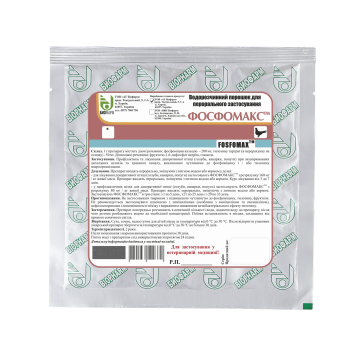FOSFOMAX
(water-soluble powder for oral administration)
Description
White or yellowish powder.
Composition
1 g of the drug contains:
active ingredients: fosfomycin calcium - 200 mg,
tylosin tartrate (in terms of base) - 50 mg.
Excipients: fructose-1,6-diphosphate, glucose.
(water-soluble powder for oral administration)
Description
White or yellowish powder.
Composition
1 g of the drug contains:
active ingredients: fosfomycin calcium - 200 mg,
tylosin tartrate (in terms of base) - 50 mg.
Excipients: fructose-1,6-diphosphate, glucose.
Pharmacological properties
АТСvet Index QJ01 - antibacterials for systemic use. QJ01XX – Other antibacterials.
FOSFOMAX is a combined antibacterial drug, with action based on its constituent active ingredients.
Fosfomycin is a bactericidal antibiotic derived from phosphonic acid. It is effective against most gram-positive (Enterococcus spp., Staphylococcus spp., Streptoсоссіs sрр.) and gram-negative (Escherichia coli, Citrobacter spp., Enterobacter spp., Klebsiella spp., Morganella morganii; Proteus mirabilis; Proteus vulgaris; Serratia spp.) microorganisms.
The mechanism of action consists in inhibition of the first stage of peptidoglycan synthesis of the bacterial cell wall. As a structural analogue of phosphoenolpyruvate, it interacts with N-acetyl-glucosamine-3-o-enolpyruville-transferase enzyme, resulting in a specific, selective and irreversible inhibition of this enzyme.
Tylosin is a macrolide group antibiotic with a bacteriostatic effect and is effective against most microorganisms: Staphylococcus spp., Streptococcus spp., Diplococcus, Micrococcus spp., Corynebacterium spp., Clostridium spp., Erysipelothrix spp., Moraxella bovis, Fusobacterium spp., Leptospira, Bacteroides, Spherophorus spp., Bordetella bronchiseptica, Haemophilus spp., Pasteurella spp. і Chlamydia spp., Mycoplasma gаllisерtiсіт, M. теlеаgridis, M. sуnоviае, M. аrthritidis, M. hуоsуnоviаe, M. suiрnеітоniае, M. hуоrhinis.
The mechanism of tylosin action consists in blocking of protein synthesis in the bacterial cell by forming a complex with 50S subunits of ribosomes.
Fructose-1,6-diphosphate is an organic compound, ester of fructose and orthophosphoric acid, a product of enzymatic oxidation of glucose, the most important intermediate (intermediate compound) of glycolysis. It provides a powerful organoprotective effect in various pathological conditions associated with oxygen deficiency. The main mechanism of exogenous fructose-1,6-diphosphate action is associated with the substrate activation of phosphofructokinase, pyruvate kinase and lactat kinase and, ultimately, with an increase in the intracellular high-energy phosphate pool. Fructose-1,6-diphosphate has a double function as a drug ingredient: It provides energy support to the animal's body at the cellular level and enhances fosfomycin action by increasing its penetrating ability. Fosfomycin is attracted by its phosphate group to the phosphate group of fructose-1,6-diphosphate, penetrates into the cell, overcoming the portal system of transmembrane protein.
Fosfomycin is well absorbed when administered orally. It is slightly protein bound (<0.5%), but due to its low molecular weight and water solubility, fosfomycin diffuses well into interstitial fluids and tissues. Half-life period makes 1.9 hours. Bioavailability is not affected by feed. It is excreted unchanged in urine.
Tylosin is rapidly absorbed from the digestive tract of animals and poultry. In most species of target animals, the peak plasma concentration is reached in 1-2 hours after ingestion. The minimum concentration in blood plasma after oral administration preserves up to 24 hours. It is metabolized in liver and is primarily excreted in urine and bile, as well as in milk and eggs.
Administration
Treatment of cage birds (pigeons, canaries, parrots) and dogs with respiratory diseases (tonsillitis, tracheitis, pneumonia, bronchitis, rhinitis, sinusitis, bronchopneumonia), digestive tract (gastritis, enteritis, peritonitis), genitourinary system (nephritis, pyelitis) , urethritis, metritis, urocystitis) caused by microorganisms sensitive to fosfomycin and tylosin. as well as in secondary bacterial infections as a consequence of viral diseases.
Dosage
Orally with drinking water or feed in the following doses:
cage birds (pigeons, canaries, parrots) - 160 mg of the drug per 1 kg of body weight daily. The treatment period is 5 days.
dogs - 320 mg of the drug per 10 kg of body weight once a day for 5 days.
Contraindications
Do not use in animals with hypersensitivity to fosfomycin, tylosin or other drug components.
Do not use simultaneously with penicillins (especially with ampicillin and oxacillin), cephalosporins and lincomycin.
Do not use in animals with severe renal impairment.
Do not use for prevention, as well as for resistant pathogen strains.
Do not use in productive animals!
Precautions
Side effects
If the drug is administered in recommended doses, side effects do not appear.
In case of allergic reactions, the drug is discontinued and antihistamines are prescribed to the animal; if necessary, administer symptomatic treatment.
Special precautions for administration
The drug shall be used only after results of the microorganisms susceptibility test.
The drug is pre-dissolved in a small amount of water, by adding water to the drug, then the solution is diluted with water to the required concentration.
Drinking bowls are installed in the areas protected from direct sunlight.
Packaging
Packages made of film or foil materials on 100 and 200 g.
Storage
Store in a dry, dark place out of the reach of children at 0-30°С.
Shelf life - 2 years.
Use the drug within 30 days following the initial sampling from the package provided it is stored in a dry, dark place at 0 С-30 С.
After mixing with feed, use it within 30 days.
Drinking water with the drug shall be used within 24 hours.
For use in veterinary medicine!
